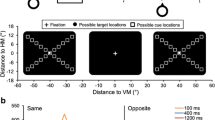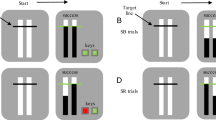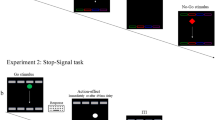Abstract
Inhibition of return (IOR), the term given for the slowing of a response to a target that appeared at the same location as a previously presented stimulus, has been studied with both target–target (TT; participants respond to each successive event) and cue–target (CT; participants only respond to the second of two events) tasks. Although both tasks have been used to examine the processes and characteristics of IOR, few studies have been conducted to understand if there are any differences in the processes that underlie the IOR that results from ignoring (CT paradigm) or responding to (TT paradigm) the first stimulus. The purpose of the present study was to examine the notion that IOR found in TT tasks represents “true” IOR whereas IOR found in CT tasks consist of both “true” IOR and response inhibition (Coward et al. in Exp Brain Res 155:124–128, 2004). Consistent with the pattern of effects found by Coward et al. (Exp Brain Res 155:124–128, 2004), IOR was larger in the CT task than in the TT task when a single detection response was required (Experiment 1). However, when participants completed one of two spatially-directed responses (rapid aiming movement to the location of the target stimulus), IOR effects from the CT and TT tasks were equal in magnitude (Experiment 2). Rather than CT tasks having an additional response inhibition component, these results suggest that TT tasks may show less of an inhibitory effect because of a facilitatory response repetition effect.



Similar content being viewed by others
References
Abrams RA, Dobkin RS (1994) Inhibition of return: effects of attentional cuing on eye movement latencies. J Exp Psychol Hum Percept Perform 20:467–477
Coward RS, Poliakoff E, O’Boyle DJ, Lowe C (2004) The contribution of non-ocular response inhibition to visual inhibition of return. Exp Brain Res 155:124–128
Deubel H, Schneider WX (1996) Saccade target selection and object recognition: evidence for a common attentional mechanism. Vision Res 36:1827–1837
Fischer MH, Pratt J, Neggers SFW (2003) Inhibition of return and manual pointing movements. Percept Psychophys 65:379–387
Godign R, Pratt J (2002) Endogenous saccades are preceeded by shifts of visual attention: evidence from cross-saccadic priming effects. Acta Psychol 110:83–102
Harvey N (1980) Non-informative effects of stimuli functioning as cues. Q J Exp Psychol 32:731–750
Hunt AR, Kingstone A (2003) Inhibition of return: dissociating attentional and oculomotor components. J Exp Psychol Hum Percept Perform 29:1068–1074
Kingstone A, Pratt J (1999) Inhibition of return is composed of attentional and oculomotor processes. Percept Psychophys 61:1046–1054
Klein RM, Taylor TL (1994) Categories of cognitive inhibiton with reference to attention. In: Dagenbach D, Carr TH (eds) Inhibitory processes in attention, memory and language. Academic, San Diego, pp 113–150
Maylor EA, Hockey R (1985) Inhibitory component of externally controlled covert orienting in visual space. J Exp Psychol Hum Percept Perform 11:777–787
Poliakoff E, Spence C, O’Boyle DJ, McGlone FP, Cody FWJ (2002) Tactile inhibition of return: non-ocular response inhibition and mode of response. Exp Brain Res 146:54–59
Poliakoff E, O’Boyle DJ, Moore AP, McGlone F, Cody FWJ, Spence C (2003) Orienting of attention and Parkinson’s disease: tactile inhibition of return and response inhibition. Brain 126:2081–2092
Posner MI, Cohen Y (1984) Components of visual orienting. In: Bouma H, Bouwhuis DG (eds) Attention and performance X. Lawrence Earlbaum Assoc, Hillsdale, pp 531–556
Posner MI, Rafal R, Choate LS, Vaughan J (1985) Inhibition of return: neural basis and function. Cogn Neuropsychol 2:211–228
Pratt J, Hillis J, Gold J (2001) The effect of the physical characteristics of cues and targets on facilitation and inhibition. Psychon B Rev 8:489–495
Rafal RD, Calabresi PA, Brennan CW, Sciolto TK (1989) Saccade preparation inhibits reorienting to recently attended locations. J Exp Psychol Hum Percept Perform 15:673–685
Roggeveen AB, Prime DJ, Ward LM (2005) Inhibition of return and response repetition within and between modalities. Exp Brain Res 167(1):86–94
Rosenbaum DA, Gordon AM, Stillings NA, Feinstein MH (1987) Stimulus-response compatibility in the programming of speech. Mem Cognit 15:217–224
Rosenbaum DA, Jorgensen MJ (1992) Planning macroscopic aspects of manual control. Hum Mov Sci 11:61–69
Samuel AG, Kat D (2003) Inhibition of return: a graphical meta-analysis of its time course and an empirical test of its temporal and spatial properties. Psychon B Rev 10:897–906
Tassinari G, Campara D, Benedetti C, Berlucci G (2002) The contribution of general and specific motor inhibitory sets to the so-called auditory inhibition of return. Exp Brain Res 146:523–530
Taylor T, Donnelly MPW (2002) Inhibition of return for target discriminations: the effect of repeating discriminated and irrelevant stimulus dimensions. Percept Psychophys 64:292–317
Taylor TL, Klein RM (2000) Visual and motor effects in inhibition of return. J Exp Psychol Hum Percept Perform 26:1639–1656
Terry KM, Valdes LA, Trammell WT (1994). Does “inhibition of return” occur in discrimination tasks? Percept Psychophys 55:279–286
Tremblay L, Welsh TN, Elliott D (2005) Between-trial inhibition and facilitation in goal-directed aiming: manual and spatial asymmetries. Exp Brain Res 160:79–88
Welsh TN, Elliott D, Anson JG, Dhillon V, Weeks DJ, Lyons JL, Chua R (2005) Does Joe influence Fred’s action? Inhibition of return across different nervous systems. Neurosci Lett 385:99–104
Acknowledgements
This research was supported by a Natural Sciences and Engineering Research Council of Canada grant. We would like to thank Daniel Peluso for collecting the data for this project.
Author information
Authors and Affiliations
Corresponding author
Rights and permissions
About this article
Cite this article
Welsh, T.N., Pratt, J. Inhibition of return in cue–target and target–target tasks. Exp Brain Res 174, 167–175 (2006). https://doi.org/10.1007/s00221-006-0433-7
Received:
Accepted:
Published:
Issue Date:
DOI: https://doi.org/10.1007/s00221-006-0433-7




